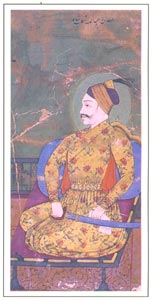 |
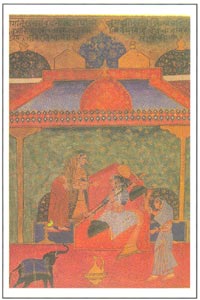 |
|
Sultan Abdulla Qutb Shah, Bijapur, circa 1940 A.D., National Museum, New Delhi |
Ragini Pathamsika, Bijapur/Ahmadnagar, circa 1595 A.D., National Museum, New Delhi |
|
|
Deccan Miniature Paintings
Deccani painting denotes broadly the miniature paintings rendered from the 16th to the 19th century at Bijapur, Ahmadnagar, Golkonda and Hyderabad, the former states that formed the region known as Deccan. Besides a distinct geographical identity, Deccan had its own distinction in art, culture, dramatics, linguistics, social values, costumes, religious beliefs, thoughts and ideas. The style and themes in Deccani miniatures, are an amalgamation of various art elements and influences, especially the elements of early indigenous art traditions of the Deccan and the Islamic idiom of Iran, Persia and Turkey.
 |
 |
|
Sultan Abdulla Qutb Shah, Bijapur, circa 1940 A.D., National Museum, New Delhi |
Ragini Pathamsika, Bijapur/Ahmadnagar, circa 1595 A.D., National Museum, New Delhi |
This Deccani art had three distinguishable phases. The early phase evolved at the Adil Shahi court of Bijapur in the beginning of the 16th century. In 1489-90, an Iranian immigrant, Yusuf Adil Shah, a soldier rising to the height of a Shah, founded at Bijapur the Adil Shahi rule. On his invitation several Irani, Persian and Turkish painters, calligraphers and scholars came to his court. Adept in Islamic art style, these immigrating artists rendered paintings on pure Islamic themes and in a pure Islamic idiom. It was Indian art only to the extent that it was rendered on Indian soil. The art of these Islamic painters was confined to text illumination.
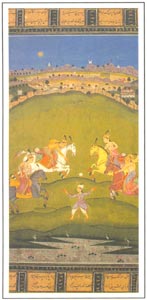 |
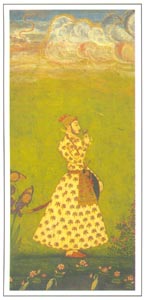 |
|
Chand Bibi playing polo, Golkonda, circa 1750 A.D., National Museum, New Delhi |
Prince holding flower, Golconda, circa 1700 A.D., National Museum, New Delhi |
A number of the descendants of Yusuf Adil Shah had a great fascination for art and patronised artists. Today, except for a few illuminated copies of the Holy Quran or its Surahs and those of the legends like Anwar-i-Suheli and Yusuf-Zulekha of the period of Quli Qutab Shah, none of the works rendered under them is now available. In these early works the art of painting had a role confining to text illumination and decoration. Blue, red and pink, the chosen colours of Deccan used in strong tones, define this phase. Designing patterns have a geometric thrust and tend to be highly symmetrical. In their style and artistic merit these works mark a departure from the prior mural tradition of the Deccan and have an identity distinct from miniatures of other regions including Mughal India.
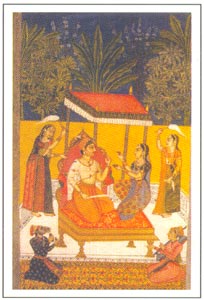 |
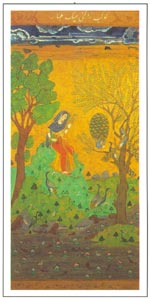 |
|
Raga Malkauns, Golconda, circa 1725, National Museum, New Delhi |
Raga Kakubha, Golkonda, circa 1720 A.D., National Museum, New Delhi |
Later generations of Muslim rulers of Deccani states, Bijapur, Golkonda, Ahmadnagar and subsequently Hyderabad, had their roots in Indian soil with little of Iran, Persia or Turkey in them. Rulers like Chand Bibi turned to be highly patriotic and some of them inclined even to Indian mysticism. Besides, the artists they had were mostly local or the local descendants of earlier immigrants. Thus, the Islamic idiom was yet the same but the earlier extraneous elements had been largely replaced by the indigenous. The Islamic idiom and a blend of different elements defined the art-style of the Deccan, but the proportion of the ‘local’ was now quite sizeable. The liberal attitude allowed depiction of not only Indian subjects but also of erotic situations.
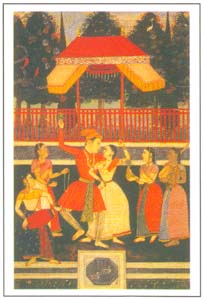 |
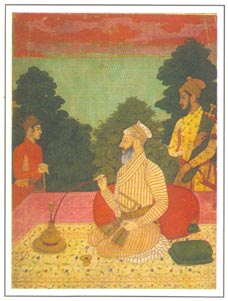 |
|
Raga Basant, Golkonda, circa 1690-1700, National Museum, New Delhi |
Shahbaz Khan Kambo smoking huqqa, Golkonda, 1683 A.D., National Museum, New Delhi |
There evolved in the early 18th century at Hyderabad yet another form of Deccani art. It blended with the romantic fervour of the former Golkonda school the stylistic elements and refinement of Mughal art. When, after the death of Aurangzeb in 1707, the glory of the Mughal court began waning, many of the artists of the Mughal court migrated to Hyderabad. These artists effected the synthesis wherein the Mughal elements were the latest to amalgamate.
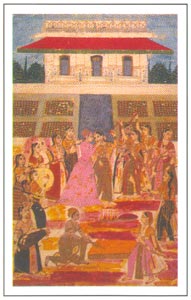 |
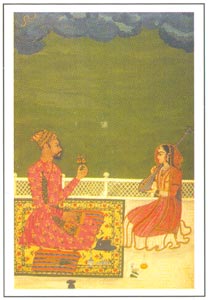 |
|
Prince playing Holi in harem, Golkonda, circa 1700 A.D., National Museum, New Delhi |
Prince enjoying Music, Golkonda, circa 1710-20 A.D., National Museum, New Delhi |
In its fully evolved form Deccani miniature art stands in merit and refinement on a parallel footing with the Mughal art. Deccani miniatures reveal the rhythmic delicacy of Persia, the lush sensuality of the Deccan and the restraint of European and Turkish portraiture. These Deccani paintings, with highly charged compositions and intense colours, reflect in them a moody romanticism, such as even a Mughal miniature rarely has.
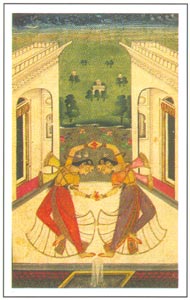 |
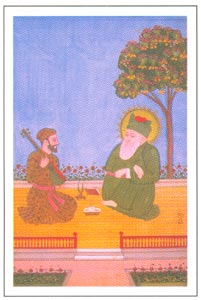 |
|
Dancers, Hyderabad, circa 1750 A.D., National Museum, New Delhi |
Hazrat Nizam-ud-Awaliya, and Amir Khusro, Hyderabad, circa 1750-70 A.D., National Museum, New Delhi |
Tall, fair complexioned and emotionally charged males and sensuous looking females populate the human world of Deccani art. They are endowed with lovely faces, large wide open eyes, bold features, broad foreheads, high necks, triangularly slanting waists and neatly carved figures, each one characterised by excitement, vigour, moods, sentiments and dramatic intensity infused into its being. Elegantly coloured costumes usually consisting of beautifully embroidered white muslin coats and a few fine pieces of jewellery adorn them. The harmoniously manipulated colours in a Deccani miniature not only reveal various forms but also various moods.
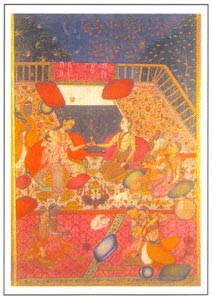 |
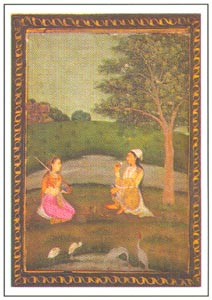 |
|
Ladies enjoying wine, Hyderabad, circa 1750 A.D., National Museum, New Delhi |
Lady observing austerity, Hyderabad, circa 1750 A.D., National Museum, New Delhi |
Geometry plays a significant role in the symmetrical arrangement of various parts in a Deccani miniature. Human figures, architectural structures, trees, shrubs, flowers, leaves, bolsters, cushions, folds of garments and even different body parts of a figure have a measured placing creating an unnoticed but accurate symmetrical balance. The building structures are usually tall and neatly drawn. These miniatures are endowed with perspectives of depth and distance and have hence a multi-dimensional effect, obviously the elements of Persian and European renaissance. This magnifies the small canvas of a Deccani miniature to look larger than its actual size and illuminates landscape and background which otherwise consist of typical local hills and fruit laden mango and palmyra trees with squirrels and parrots on them.
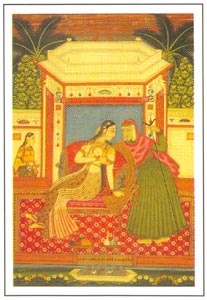 |
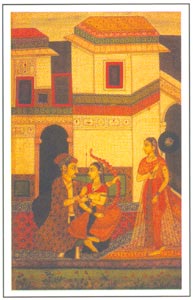 |
|
Princess with confident, Hyderabad, circa 1780 A.D., National Museum, New Delhi |
Raga Vibhasha, Hyderabad, circa 1700 A.D., National Museum, New Delhi |
Dr. Daljeet
(Source: Gallery Sheets of Indian Miniature paintings published by the National Museum. New Delhi)
|
|